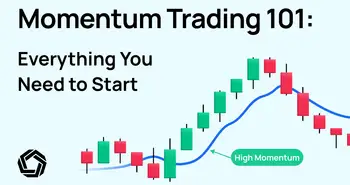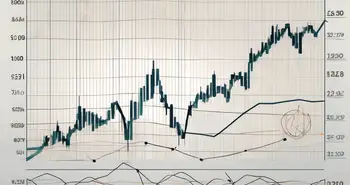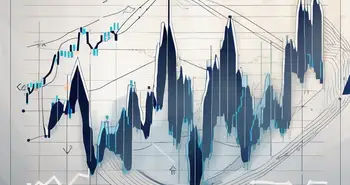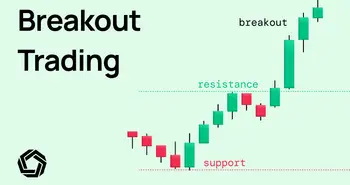Momentum Trading Strategies

In this article, we'll take a closer look at what momentum trading is, how it's influenced by market conditions, and some of the most effective strategies for making the most of this exciting approach to trading. So let's get started and discover how you can harness the power of momentum to take your trading game to the next level!
- What is Momentum Trading
- Factors Affecting Momentum Trading
- Momentum Trading Strategies
- Parabolic SAR & EMA Cross
- RSI & SuperTrend Indicator
- Heikin Ashi for Improved Performance
- Conclusion
What is Momentum Trading
Despite the efficient market hypothesis proposed by Fama in 1970, which claims that market trends follow a random walk, several researchers have discovered market anomalies that contradict this theory. These anomalies include momentum trading, which has been referred to as the “premier anomaly” by Fama.
Momentum trading involves buying stocks that have shown recent upward momentum and selling stocks that have shown recent downward momentum. This strategy is based on the idea that recent winners will continue to perform well in the near future while recent losers will continue to perform poorly.
While the idea of momentum trading is not new, it gained significant attention after a paper by Jegadeesh and Titman in 1993, where they showed that buying past winners and selling past losers can generate alpha. Since then, numerous variations of momentum strategies have been developed, and momentum research has been divided into four main clusters: testing profitability, identifying sources of momentum profits, and improving momentum strategies.
Here is a simple explanation of the concept of momentum, aka. Relative Strength, by Tom Dorsey:
If I gave you a list of the 100 best golfers worldwide and asked you to pick who you thought would be in the top 10 at the end of the next quarter, who would you pick? My guess is you would pick the current top ten to be in the top three months from now. Even if I asked you to pick the ones who would be in the top ten after one year, you would probably pick the current top ten.
At the end of the contest, some would have fallen out, and some would have moved up, but the majority would still be in the top ten. This is outperformance. It relates to Newton’s Law of motion, which suggests that objects that are in motion tend to stay in motion until an external force acts upon them. We believe that stocks that have good fundamentals, in a market that in general is supporting higher prices, and the chart pattern clearly shows that demand is in control of the stock, tend to continue to do well. Golfers who have good fundamentals, are in good shape, and at the top of their game, tend to continue to do well.
Buy the winners.

So, as you can see, the success of a momentum trading strategy relies on identifying a momentum rule. This rule could be anything and we will show you multiple strategies that rely on momentum a bit later in this article. Let’s take a very classical and easy example without any fancy indicators or formulas for now.
The most simple momentum strategy typically involves selecting a window of time and using price data, such as daily closing prices. In one study, for example, Bitcoin's daily closing prices were examined, and the author utilized a window of three. A buy signal is generated when the mean of the recent three returns is positive, indicating an upward momentum, while a sell signal is generated when the mean is negative, indicating a downward momentum. In that case, a momentum strategy outperformed Bitcoin's simple hold-and-buy strategy.
“The high volatility might also explain why the momentum strategy overperformed the buy and hold strategy significantly. Due to the spikes, momentum could be traded up and down, unlike with the passive buy and hold strategy. Thus, the momentum effect created more opportunities over the sample period for generating high returns.”
Kevin Klammer

In conclusion, momentum trading has proven to be a viable strategy in the world of finance, despite contradicting the efficient market hypothesis. By identifying recent winners and losers, momentum traders can generate alpha and potentially outperform the market.
Factors Affecting Momentum Strategies
The stock market has always been a psychology-driven rollercoaster, with prices swinging wildly in both directions. Some investors are panicking, selling off their stocks left and right, while others are eagerly looking for opportunities to buy low and sell high. And then there are the momentum traders – those who try to ride the wave of market momentum to make a profit.
During times of strong market trends, momentum traders can do very well. They buy stocks that have been performing well, hoping to continue riding that upward momentum. But when market conditions become volatile, things can get trickier. While it's true that some momentum traders may choose to short the market during these times, others may find it difficult to identify clear trends in a market that seems to be constantly changing direction.
That's where technical indicators come into play. By using technical analysis and indicators like moving averages or the relative strength index (RSI), momentum traders can identify potential buying or selling opportunities based on price trends and other data. But even with these tools at their disposal, it can be tough to navigate the volatile market.
Other factors can also impact momentum trading. For example, news and events can cause sudden shifts in market sentiment, leading to sharp changes in stock prices. High liquidity and trading volume can make it easier for traders to enter and exit positions quickly, but they can also make it more difficult to spot good opportunities in a crowded field.
Indeed, macroeconomic trends and policy decisions can also significantly impact momentum trading strategies. For example, changes in interest rates can affect stock prices and cause shifts in market momentum. A decrease in interest rates can stimulate economic growth, leading to increased stock prices and creating opportunities for momentum traders to ride the wave.
Similarly, policy decisions made by central banks or governments can also have an impact. For instance, quantitative easing – the process by which central banks inject liquidity into the economy – can lead to increased market liquidity and potentially create opportunities for momentum traders.
Ultimately, while many factors can impact momentum trading strategies, it's important to remember that the market is ultimately a game of liquidity.
“It's the liquidity, stupid! S&P 500 trades in tandem w/liquidity of global central banks. Liquidity matters, always!”
Holger Zschaepitz
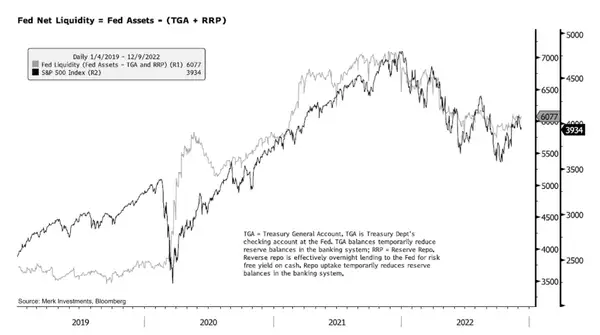
Understanding how changes in interest rates, policy decisions, or other macroeconomic factors can affect market liquidity can be a key factor in determining when to enter or exit positions, and in managing risk effectively.
Momentum Trading Strategy Ideas
Parabolic SAR and EMA Cross
Let’s dive into the first momentum trading strategy, which combines the Parabolic SAR and the Moving Average with the EMA Cross. As a live demonstration, we will use the price movement of CORN commodity, however this strategy could be used on any asset.
The Parabolic SAR is a technical analysis indicator that uses dots above or below price bars to indicate potential reversal points in the direction of the trend. It can be useful for identifying stop-loss orders as the dots move in relation to price and accelerate as the trend continues.
The Moving Average with the EMA Cross strategy combines two exponential moving averages (EMAs) of different time periods to identify bullish or bearish trends. In this case, the length of the MA is 9, and the length of the EMA is 26. When the shorter EMA crosses above the longer EMA, it suggests a bullish trend, while a cross below indicates a bearish trend. It’s a popular and simple strategy that helps you to identify entry and exit points.
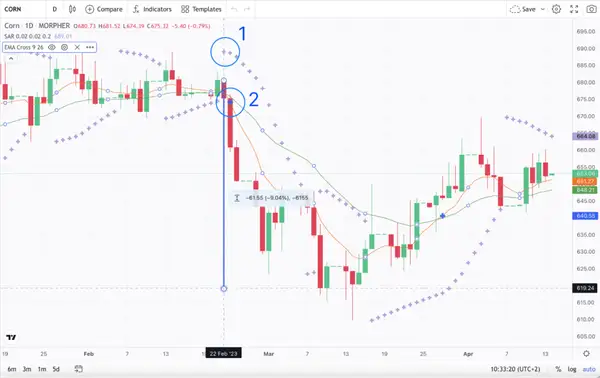
Now, let’s analyze the charts. In early July 2022, the market trend of CORN was sideways. However, on the following day, the Moving Average indicator showed a Cross (indicated by “2” in the chart), hence trend reversal, and the Parabolic SAR indicated a potential short position (indicated by “1” in the chart). These indicators signaled that momentum had changed, and it was time to make a trading decision.
You could have entered the short position seeing the EMA Cross and spotting the Parabolic SAR signal. By taking a short position from roughly 760 to 620 (indicated by the info trendline), you could have potentially yielded a significant profit of around 10% or even much more when trading with leverage.
RSI and SuperTrend Indicator
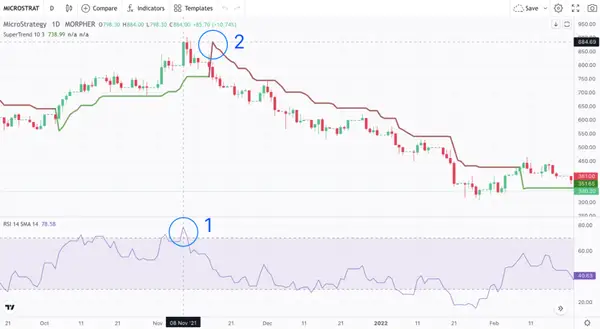
In this trading strategy, we combine two indicators to identify potential momentum strategy with the RSI and the SuperTrend. As a live demonstration, we will use the price movement of the MSTR stock, however this is a general strategy and can be used on any asset.
The RSI measures the strength and momentum of an asset's price action and identifies overbought patterns with a reading above 70 or oversold patterns with a reading below 30. Meanwhile, the SuperTrend indicator identifies entry/exit points based on the price’s relationship with a band calculated using the average true range and a moving average. It is plotted above or below the closing price to signal a buy or sell. You can see it on the chart as this thicker line changes from brown to green along the candlesticks. The indicator changes color based on whether one should buy or sell. If the SuperTrend indicator moves below the closing price, it turns green, signaling a buy entry point.
As we analyze the charts, we can see an uptrend in MSTR, with a new top formed on November 8, 2021, followed by a reversal the next day. The RSI indicator confirms that the asset is overbought, with a value of around 75 (indicated by “1” in the chart), suggesting a potential trend reversal. The SuperTrend indicator also confirms the trend reversal, changing color from green to brown (indicated by “2” in the chart).
Based on this information, we identify a good entry position for a short trade at around the 700 mark. This position could continue until around the 400 mark, where the RSI turns in the opposite direction with a value below 30, indicating oversold conditions. Alternatively, we could have waited for the SuperTrend indicator to turn green again, providing further confirmation of the trend reversal.
It's worth noting that Microstrategy is highly correlated with Bitcoin due to its significant amount of holdings. As such, any major changes in the cryptocurrency market could also affect the stock's price and momentum. However, with the RSI and SuperTrend indicators, we can confidently make trading decisions based on the current market conditions and price action.
Heikin Ashi for Improved Performance
You might already know what Heikin Ashi Candles are; however, if not, it is wise to use them for your momentum strategies. Heikin Ashi mostly help you to identify and trade momentum trends. Unlike traditional candlestick charts, Heikin Ashi candles serve as sort of a “Moving-Average” of charts, making them better suited for longer-term trend-following strategies instead of quick trading decisions.

By analyzing the chart example below using Heikin-Ashi candles, we can identify two clear trends: a downtrend and an uptrend. The color of the Heikin-Ashi candles remains consistent over a given period, providing an indication of potential trend reversals when the color changes. Additionally, changes in the size of the candles and shadows offer further insight into potential market movements. So overall, they might be a great addition to your arsenal when trading momentum strategies.
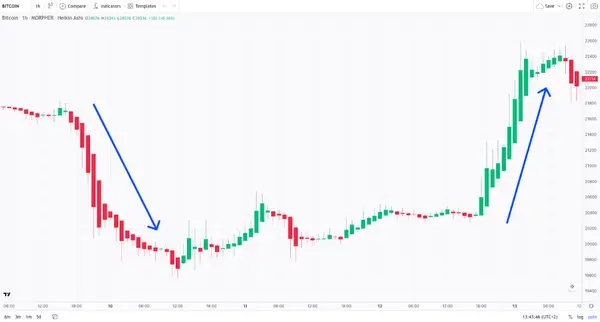
Conclusion
In the end, we hope you will take the momentum you gained from reading this article and apply it to some live charts to hopefully profit from it. We've explored some of the most effective strategies for making the most of this exciting approach to trading. From riding market trends to identifying key signals, plenty of ways to leverage momentum to your advantage exist. Go for it!

Disclaimer: All investments involve risk, and the past performance of a security, industry, sector, market, financial product, trading strategy, or individual’s trading does not guarantee future results or returns. Investors are fully responsible for any investment decisions they make. Such decisions should be based solely on an evaluation of their financial circumstances, investment objectives, risk tolerance, and liquidity needs. This post does not constitute investment advice.

Painless trading for everyone
Hundreds of markets all in one place - Apple, Bitcoin, Gold, Watches, NFTs, Sneakers and so much more.

Painless trading for everyone
Hundreds of markets all in one place - Apple, Bitcoin, Gold, Watches, NFTs, Sneakers and so much more.

